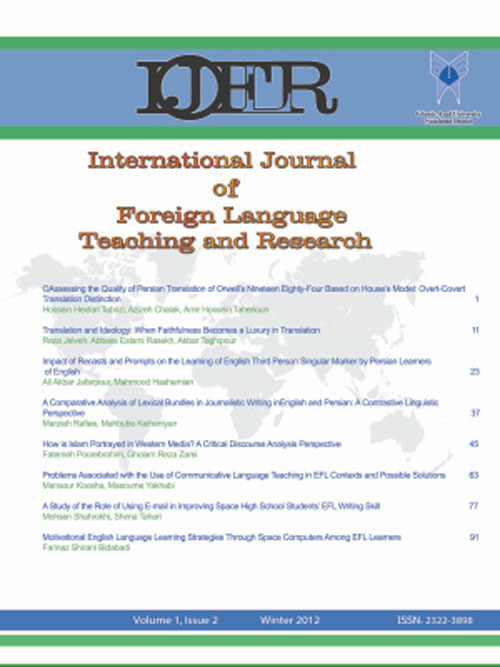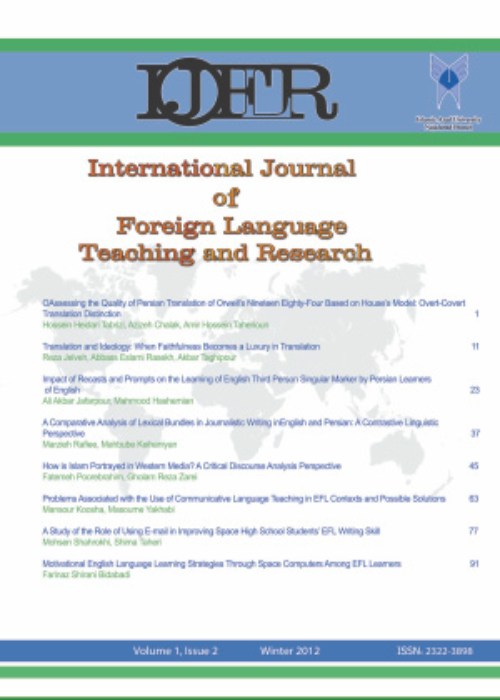فهرست مطالب

International Journal of Foreign Language Teaching and Research
Volume:5 Issue: 19, Autumn 2017
- تاریخ انتشار: 1396/05/07
- تعداد عناوین: 9
-
Pages 11-23This study was carried out to investigate the relationship between foreign language listening anxiety and listening comprehension. The study employed correlational study design. Participants of the study were 40 grade 11 students who attended the listening class in 2015/2016. Foreign language listening anxiety questionnaire and listening comprehension tests were used as data gathering instruments. These data were analyzed using Pearsons Product moment correlation and one way ANOVA. In order to identify the significance of differences between the pairs of FL listening anxiety, multiple comparisons or a post hoc test was also conducted. The results revealed that there was a significant, negative correlation between listening comprehension and foreign language listening anxiety. The findings also showed that the mean differences were statistically significant between the low anxiety and average anxiety, low anxiety and high anxiety and average anxiety and high anxiety.Keywords: Anxiety, listening comprehension, foreign language listening, foreign language listening anxiety
-
Pages 25-36The purpose of the present study is to analyse abstracts related to Applied Linguistics, and more precisely the discourse functions of grammatical subjects and verbs. The corpus consisted of 50 PhD thesis abstracts written on the subject of Applied Linguistics. All of the abstracts were written from 2010 to 2014. The theses from which the abstracts were extracted are available in the ProQuest database. Based on the model put forth by Swales and Feak (2004), the elements of the abstracts were identified. In accordance with Ebrahimi (2014), frameworks were used to analyse discourse functions, while the realisation of grammatical subjects and verbs was analysed for tense types. The results revealed that the introducing part of study and research-related objects were the predominant types of grammatical subjects. Indeed, these performed more discourse functions in Applied Linguistics PhD thesis abstracts compared with other grammatical subject types. The results also indicated that simple past tense was predominant in aim, method, and results sections, while the simple present was predominant in the background and conclusion sections.Keywords: academic writing, thesis abstract, grammatical subject, verb, genre
-
Pages 37-50The present study aimed firstly at investigating the impact of translator's style on figurative language translation from English into Persian. Secondly, it intended to find which strategies were most frequently adopted by Persian translators to translate figures of speech into Persian. Lastly, the study sought to check the extent of transference of figurative features of literary texts in English-Persian renderings. To achieve these purposes, the English novel, Little Women by Alcott (1880) and its three Persian translations by Raiszadeh (1997), Akhavan (1996), and Morvarid (2000) were used as the materials of the study. The original novel, along with its three selected translations, were first studied carefully by the researchers and about fifty percent of the novel was chosen to be analyzed in terms of figures of speech, which are part of stylistic features of any literary text. Then, the figures of speech in the stated sample, besides the Persian equivalents of each of them used by the three translators, were identified. Finally, a hybrid model incorporating 5 strategies retrieved from Newmrak's (1988) and Baker's (1992) models of translating figurative language was utilized to examine the identified tropes and determine the type and number of strategies employed by any individual translator. The obtained results revealed that figurative language devices were translated from the source into the target language through a variety of strategies, which can be indicative of the translators stylistic tendencies.Keywords: Translator's voice, style, literary devices, novel, figurative language
-
Pages 51-60Acquiring vocabulary has always been recognized as a significant and challenging part of language learning process. In this study, the researcher examined the extent to which form recall of target lexical items by learners of English as a foreign language (EFL) is affected by a) repetition and b) by the type of target item; single words versus collocations. The treatment consisted of non-communicative, (partly) decontextualized activities, in which the target items were taught and examined. For this purpose, 27 Iranian intermediate EFL learners were chosen and divided into two groups of A with 14 and B with 13 participants. In all activities, the participants had to supply the target items forms. Data were collected in a classroom setting in two groups, differing only in the type of target item. In class A, the research focused on single words and in class B the focus was on collocations. A pre and post test was administered to the participants before and after the treatment. The findings show a large effect of spaced repetition on form recall of single words and collocations. However, the participants in class A who were treated with single words outperformed the other group.Keywords: Collocation, form recall, repetition, single word, spaced repetition
-
Pages 61-77This study aimed to investigate the relationship between HEXACO personality traits and Iranian EFL learners speaking ability. In order to achieve the purpose of the study, among all the language institutes (fifteen institutes) in Amol, Mazandaran Province, 8 were selected randomly (four institutes for female and four institutes for male language learners). Then, two classes were selected randomly from each institute. Among all the language learners in these eight institutes and classes, 250 learners (125 male and 125 female learners) were selected using a random cluster sampling method. The participants were asked to complete the HEXACO personality traits questionnaire. Speaking ability of all the learners was checked via scored interview to examine the relationship between HEXACO personality traits (Honesty-Humility, Emotionality, Extraversion, Agreeableness, Conscientiousness, and Openness to Experience) and their speaking performance. Speaking ability of the learners were evaluated by three interviewers (the researcher and two trained raters) based on IELTS speaking bands in four areas: 1) Fluency and Coherence 2) Lexical Resource 3) Grammatical Resource 4) Pronunciation. The interview was scored out of 9 in this study. To analyze the collected data, Pearsons correlation coefficient and multiple regressions with stepwise method were used in the study. The findings of the study showed a positive and significant relationship between HEXACO personality traits and speaking performance of the learners. Extraversion, conscientiousness and altruism could predict 90.3 percent of variance of speaking ability.Keywords: HEXACO personality traits, Speaking ability, honesty-humility, emotionality, Extraversion, conscientiousness
-
Pages 79-89Although English language plays an important role in the job of aviation personnel, language needs of these employees have been taken for granted. This study aimed at investigating the extent to which English is used by the employees at Iran Air airport services at Isfahan Airport, the required level of basic language skills in performing their jobs effectively, and the employees attitude towards their English professional courses. A questionnaire consisting of 24 items was constructed and distributed among all the employees working at three sections of Iran Air airport services (Ramp Control, Customer Services, and Baggage Services). Besides, Observation was done by the researcher at the airport to find out the basic language problems of the aviation personnel, and interviews were done with the head of each sections. The findings proved that English language is highly used in the employees jobs and they are not satisfied with their training courses. Also, the Ramp Control and Baggage Services employees considered speaking as the most important skill, while Baggage Services employees considered reading and writing as the important ones. Finally, it can be concluded that revision of the current professional training programs seems to be necessary to offer appropriate ESP course curriculum.Keywords: Airport services employees, aviation, English for Specific Purposes, Iran Air, needs analysis
-
Pages 91-109While listening plays an important role in the process of foreign/second language learning, different factors can affect this process. This study was designed to assess the relationship between listening anxiety and metacognitive strategy awareness with a special interest in the role of gender and proficiency level. In order to conduct this survey, two instruments including the Metacognitive Awareness Listening Questionnaire (MALQ) as well as Foreign Language Listening Anxiety (FLLA) questionnaire were utilized and distributed among 105 upper-intermediate and advanced level Iranian EFL learners. The analysis of data indicated that there was a negative correlation between the participant's listening anxiety and their use of metacognitive strategies, indicating as the use of metacognitive strategies increased, lesser degrees of listening anxiety were observed and vice versa. Moreover, the findings showed that there was no difference between males and females in this regard. Regarding learners level, it was revealed that upper-intermediate learners were more anxious than advanced level ones. However, no difference was detected between these two levels in their strategy use. It is hoped that this study can help teachers to consider their learners characteristics in the instruction of suitable strategies and learners to become more autonomous and self-regulated in their listening performance.Keywords: Listening anxiety, metacognitive strategy awareness, Gender, proficiency level
-
Pages 111-124This study investigated the effects of English as foreign language (EFL) proficiency on what the authors of this study called pragmalinguistic and sociopragmatic recognition of EFL learners. To elicit the data, the study used two types of pragmatic measures: a pragmalinguistic recognition (PLR) test and a sociopragmatic recognition (SPR) test. Both tests were developed by the researchers of this study based on the distinction made by Leech (1983) between pragmalinguistics and sociopragmatics. Subsequent to the development of the tests, 80 Iranian EFL students were divided into two groups based on their EFL proficiency level: the low level group (n = 41) and the high level group (n = 39). Each participant group was tested on the two pragmatic measures. Pearson correlation results indicated construct differences between PLR and SPR of speech acts. Moreover, independent samples t-test results revealed that there were developmental differences in pragmalinguistic and sociopragmatic recognition of speech acts by EFL learners. The findings offer insights to EFL teachers and testers regarding pragmatic instruction and assessment.Keywords: EFL, Language proficiency, pragmalinguistic, Recognition, sociopragmatic
-
Pages 125-138This study explores the relationship and interconnections between EFL teachers beliefs and their motivational practices in the classroom. The present study combined qualitative and quantitative methods of research. First, the motivational practices of 30 teachers in two private language schools in Tehran were explored with a classroom observation instrument, the Motivation Orientation of Language Teaching (MOLT) which was used to estimate the time that teachers spent for each motivational strategy. Then, teachers beliefs were examined through the Beliefs about Language Learning Inventory (BALLI) and an open-ended questionnaire aimed to assess beliefs about motivational strategies. The quantitative results indicated that the higher the teachers scores on the BALLI, the less frequently their use of motivational strategies in the classroom. The findings based on qualitative data, drawing largely on data from observations and the open-ended questionnaire, showed that although teachers were observed to generally follow their beliefs, there existed several points of difference between their beliefs and practices. Also, there was evidence that what teachers practice in the classrooms does not always impact their beliefs.Keywords: Motivation, motivational strategies, teacher's beliefs, teacher variables, ELT


